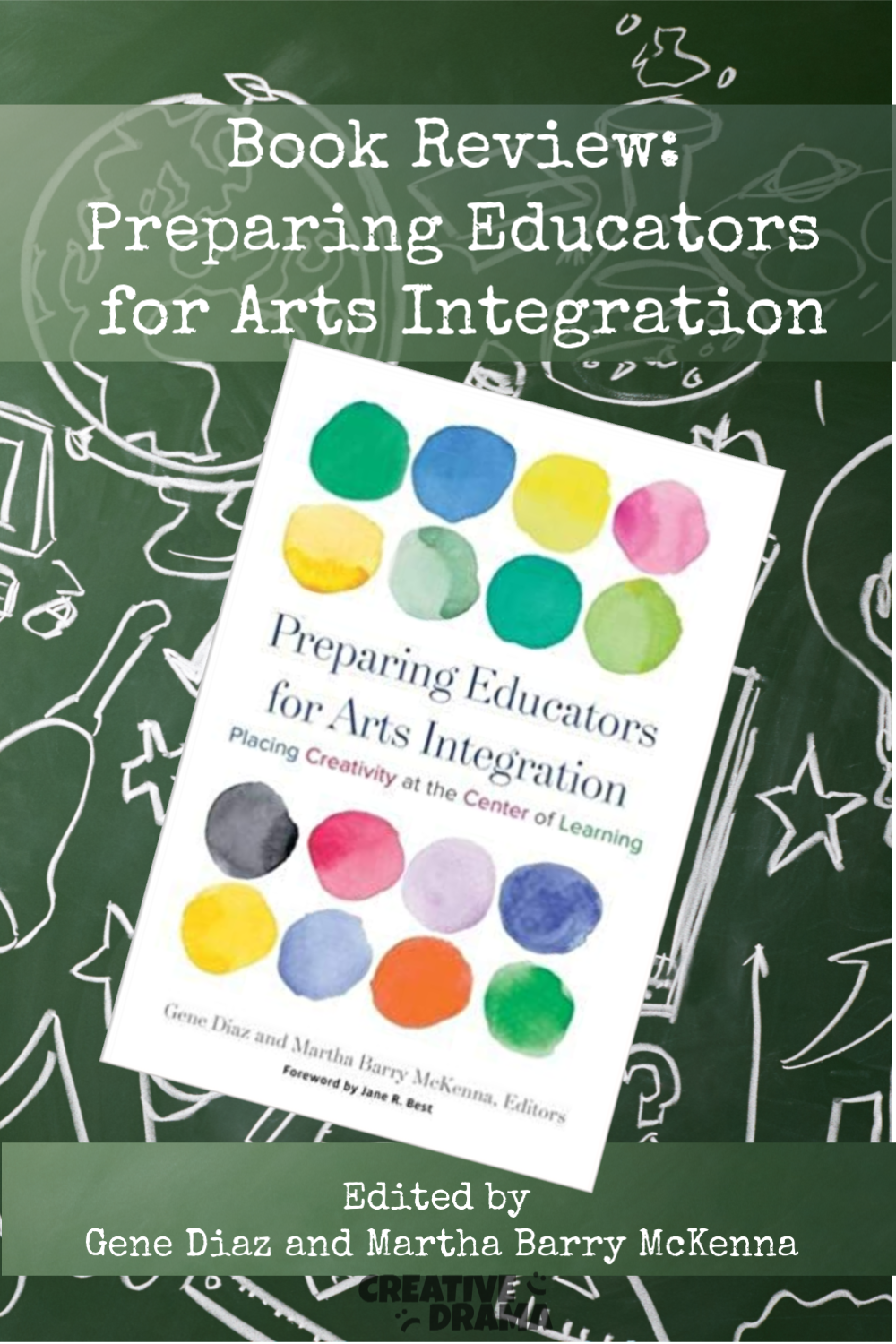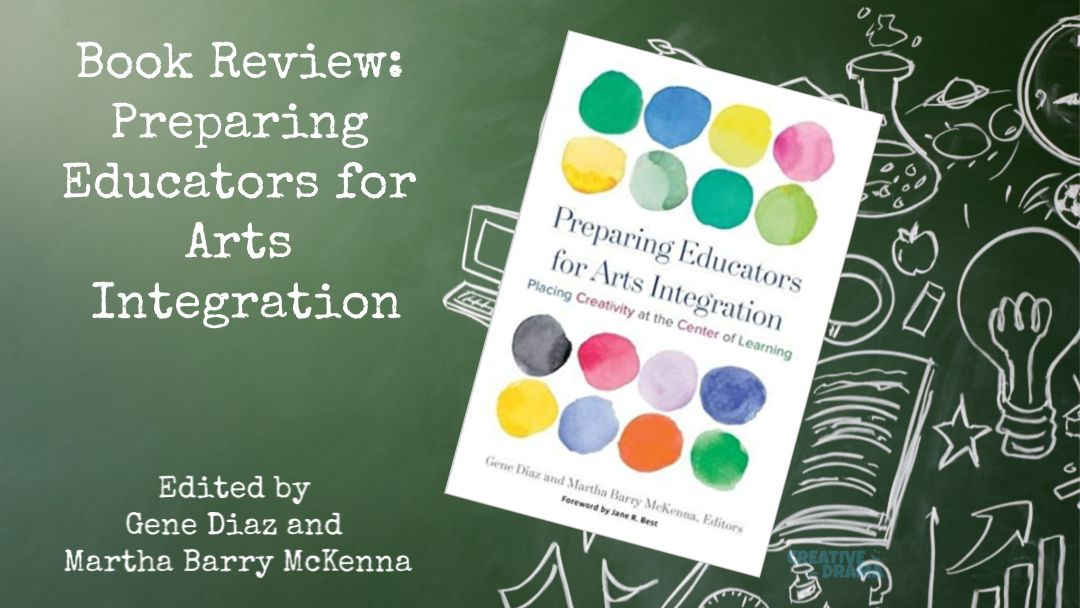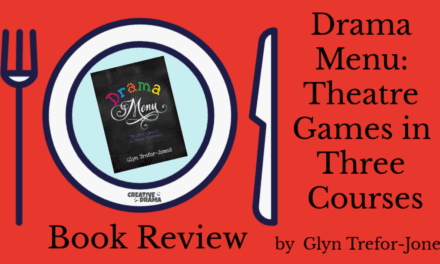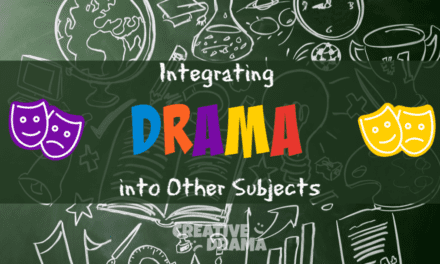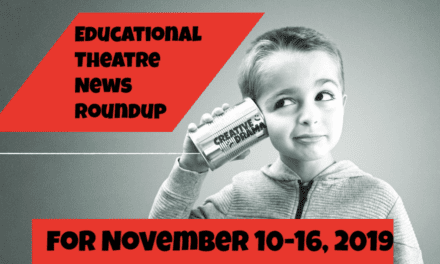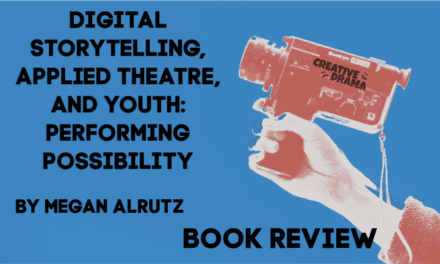INTRODUCTION
Preparing Educators for Arts Integration: Placing Creativity at the Center of Learning, edited by Gene Diaz and Martha Barry McKenna, is a collection of essays and reports which focuses on the professional development and teacher education of both arts specialists and “regular” classroom teachers in Arts Integration. The pieces cover a wide range of educational situations, geographic areas, and student abilities; many have some connection to the editors through the Arts Education Partnership, or Lesley University.
Diaz and McKenna arranged the book into five parts with an additional “Conclusions and Recommendations” section.
The book is most useful for:
- school administrators
- education professors
- professional development leaders
- curriculum supervisors
- arts administrators
– who are looking to design professional development opportunities for teachers or arts integration programs for school-, district- and state-level systems.
Classroom teachers and teaching artists may find the pieces in the book interesting, but there’s not a lot of specifics regarding how arts integration works in the classroom with Pre-K-12 students.
In the Introduction, Diaz and McKenna emphasize that “one model or approach will not fit all schools or all learners.” (7) They are looking to “critically evaluate applications of effective approaches that could cut across these differences (in students and school resources)” (7).
Preparing Educators for Arts Integration encompasses all of the arts – performing and visual – but for the purposes of my Independent Study (“Very Recent Reads in Theatre Education”), I’m looking books from my perspective as a theatre teacher. Unfortunately, there weren’t many examples of drama- or theatre-integrated curricula or lessons featured in the book. Most theatre teacher-directors, however, have enough imagination to see how they might apply the ideas presented to their subject matter, or integrate techniques into other curricula.
Even though this text is a little short of my required 200 pages for a book review, the print is small and the text is dense. I’ve tried to provide a sense of the content and the various essays in the book without summarizing every point the various authors made.
PART I: THEORY AND PRACTICE IN ARTS INTEGRATION
In the opening to this section, the editors explain that readers need to know the basics of constructivist pedagogy, since they apply to both students in K-12 schools and learners in professional development situations. Basically, learners create their knowledge rather than having it thrust upon them. There’s a good and easy-to-digest explanation of constructivism at the Cult of Pedagogy.
“Using the Creative Process as Pedagogy” by Gene Diaz and Martha Barry McKenna
Diaz and McKenna share a methodology for professional development – getting teachers to create art in order to understand what they’re asking their students to do. They outline four components of the creative process as pedagogy:
- Building the Environment for Creative Process – this is not just the pictures, objects, and multimedia available in the classroom; it’s also the students’ engagement with art outside of the classroom. “Placing learning in artistic spaces…deepens creative engagement in making and interpreting works of art.” (23)
- Exploring Together – Teachers who use arts integration have to be comfortable co-constructing meaning; that is, they have to discover alongside their students instead of having all the knowledge to start.
- Designing and Constructing – The professional development classes require students to create original works of art as final projects. Diaz and McKenna share a touching example of a student constructing a quilt from her husband’s clothing as a memorial to him.
- Engaging in Critique – Practicing critical assessment helps teachers reflect on their own work while learning how to help students evaluate theirs.
“Arts Integration and Standards Alignment” by Amy Charleroy and Pamela Paulson
Aligning curricula, units, and lessons with standards has become as common a task for teachers as taking attendance. Charlerov and Paulson examined the connections between the Common Core State Standards for English and Language Arts and Mathematics and the National Core Arts Standards. According to their study, they found many correlations. There were 50 in the Standards for Reading, 8 in the Standards for Writing, and 16 in the Standards for Speaking and Listening. They also made connections with the Common Core Standards and the Skills and Habits in the Core Arts Standards – over 50% alignment.
However, their analysis is on a very global level; there are few examples of how a teacher might exploit these connections in a lesson plan. The connections are there, but it’s up to classroom instructors to locate them and articulate them for their lesson objectives. Charlerov and Paulson don’t point out, for example, how math is necessary to create a lighting design for a production. Here’s an example:
“The ability to develop and refine artistic techniques and work for presentation relates to five of the ten Common Core Anchor Standards for writing, specifically to those that refence the ability to organize and develop ideas as well as to plan, revise, and edit one’s work.” (35)
The “Guiding Principles for Arts Alignment and Integration” Charleroy and Paulson present at the end of their study have applications for classroom teachers as well as curriculum supervisors and administrators.
“Using Curriculum Design Frameworks for Arts Integration” – Don Glass and Lisa Donovan
Don Glass and Lisa Donovan’s article examines two types of curriculum design frameworks and their suitability for arts integration work. Two different professional development programs, VSA’s Communities of Practice (the acronym comes from the old name of Very Special Arts; now VSA: The International Organization on Arts and Disability), and Lesley University’s Creative Arts in Learning’s Integrated Teaching through the Arts (ITA), evaluated the frameworks. I wasn’t surprised to read that each of the frameworks, Understanding by Design and Universal Design for Learning, were useful for designing Arts Integration Curricula; I’ve found that pedagogical systems are usually flexible enough to meet the needs of various curricula and a wide variety of teaching styles.
Glass and Donavan point out that the advantages of using curriculum design frameworks include establishing an “improvement mindset” in teachers, being able to create an “elegant fit” for interdisciplinary work, and providing a methodology for “putting standards into practice.”
PART II: STATEWIDE MODELS OF ARTS INTEGRATION
“Whole-School Models of Arts Integration: Oklahoma A+ Schools” by Jean Hendrickson
I’ve visited the websites of the National A+ Schools Consortium and Oklahoma A+ Schools™ , and I can’t figure out exactly what an “A+ School” is. There are 180 schools in their “network,” spread across 4 states, and there are public, charter, magnet, parochial and private schools on the lists. Some of the schools in Arkansas are KIPP charter schools, which I thought had their own philosophy of education.
Oklahoma A+ Schools™ are based out of the University of Central Oklahoma; they have an 11-person Advocacy Board, and a lot of educators associated with the program. Their “Donate” page says there is no “no cost to individual schools;” “made possible by generous A+ partners.” The Partners listed are nearly all nonprofits or grant-giving organizations. Jean Hendrickson, author of this paper, is the Director Emeritus for Oklahoma A+ Schools™; she served as Executive Director for 11 years.
The Oklahoma A+ Schools™ have a list of “8 Essentials” that serve as the framework for education. One of the essentials is “Arts: Value the arts as essential to Learning, teach them daily, and include them in planning” (56).
Hendrickson explains that putting the arts into the framework for the schools has two advantages:
- making sure they’re addressed in conjunction with the curriculum, rather than as a just separate “special” subject (although direct instruction in arts happens as well)
- insulating the arts from the vagaries of budgets, staffing, and administrations (56).
The framework of the schools also ensures that teachers get plenty of professional development and access to teaching artists and master teachers.
Hendrickson admits that the commitment on paper doesn’t always happen in practice; some schools have “no arts staff” (61).
“The Evolution of Arts Integration in Maryland: Working in Consortium” – Mary Ann Mears, Kathy O’Dell, Susan J. Rotkovitz, and Lori Snyder
I’m a “wordy” person; my Yoast post analyses can attest to that. But this article was challenging for me because it was very heavy on educational policy and there were SO MANY acronyms! Of course, the authors explained each before using just the letters, but when in the course of two pages, a reader encounters:
- COMAR
- MSDE
- LEAs
- FAEAP
- IHE
- PD
- YAMD
- MSAC
- MLDS
It can be a little daunting.
In Maryland, each county has its own school district, making implementation of programs on the school level easier than it would be in a state where each county has multiple school districts. Mears and her fellow authors trace the development of the Arts Education in Maryland Schools alliance, which aims to assure “equity and access to high-quality arts and arts-integrated e ducation for all students in Maryland.” AEMS serves over 350,000 students. Since three of the four most populous counties in the state are members of the consortium, this number represents slightly more than 40% of all the public school students in the state.
In Maryland, there are state-level requirements for arts learning that support arts integration; my favorite is: “all local education agencies (LEAs) provide fine arts instruction encompassing dance, media arts, music, theater, and visual arts each year and at all grade levels.”(66)
To provide professional development (PD!) for arts integration, AEMS helped create a Maryland Artistry in Teaching Institute, developed partnerships with colleges and universities in Maryland, and formed a task force to examine possible courses. They’re now working on gathering research to support arts integration, including from Johns Hopkins Brain Science Institute.
PART III: EDUCATION OF LEADERS IN ARTS INTEGRATION
In my experience as a teacher and as the parent of a student, I’ve observed distinct differences among elementary and middle schools in the same district. In the interest of parity, schools would have similar curricular and extracurricular opportunities for same grade-level students within a district, right?. But that’s not how it works in practice. My view of the situation has been that principals are sometimes running fiefdoms within their district. So I was pleased to see that the studies in “Education of Leaders in Arts Integration” found that:
“…a critical element in transforming teaching and learning through arts integration is the involvement of the principal as visionary academic leader of the process” (77).
“Preservice Teachers Advocating for the Arts” by Erik Engdahl and Peg Winkleman
Engdahl and Winkleman’s paper examines the impact of presentations made by preservice teachers (Undergraduate Education Majors) on Educational Leadership candidates (who are usually educators studying to become principals, curriculum supervisors, or other education administrators). The students presented Arts Integration advocacy pieces. The results made me simultaneously hopeful and sad for the future of arts education.
While the administrative candidates were “overwhelmingly positive” (83) in their responses to the presentations, many of them were unsure how they would be able to impact their school communities. Administrative candidates from economically disadvantaged districts in particular had concerns about costs, funding and the impact of the arts on the statistics that “matter” – test scores and attendance records. (SPOILER ALERT: The arts impact BOTH of these positively!)
“Principals Art Leadership Program” by Una McAlinden
Through developing a program specifically for school principals (the Principals Art Leadership Program through Arts Ed Washington), McAlinden discovered that the most successful method for getting arts integration into schools was getting entire districts to participate. Principals can get their faculties and students on board for arts integration, but if the support stops at that leadership level, a change in staffing or funding can negatively impact the program.
McAlinden concludes that a district approach to Arts Integration has “exponential impact” that leads “to long-term, equitable provision of the arts” (100).
“Learning from an Arts-Savvy Charter School Principal” by Elizabeth F. Hallmark
Hallmark conducted an inquiry at a small charter school that practiced arts integration across their entire curriculum; she calls it “arts as collaborative inquiry” (110). The school also had the advantage of being able to have the entire school studying time periods as 12-week investigations. At the end of each unit, the entire school hosted an “exhibition night” where the grades presented their learning through the musical, theatrical, and visual arts.
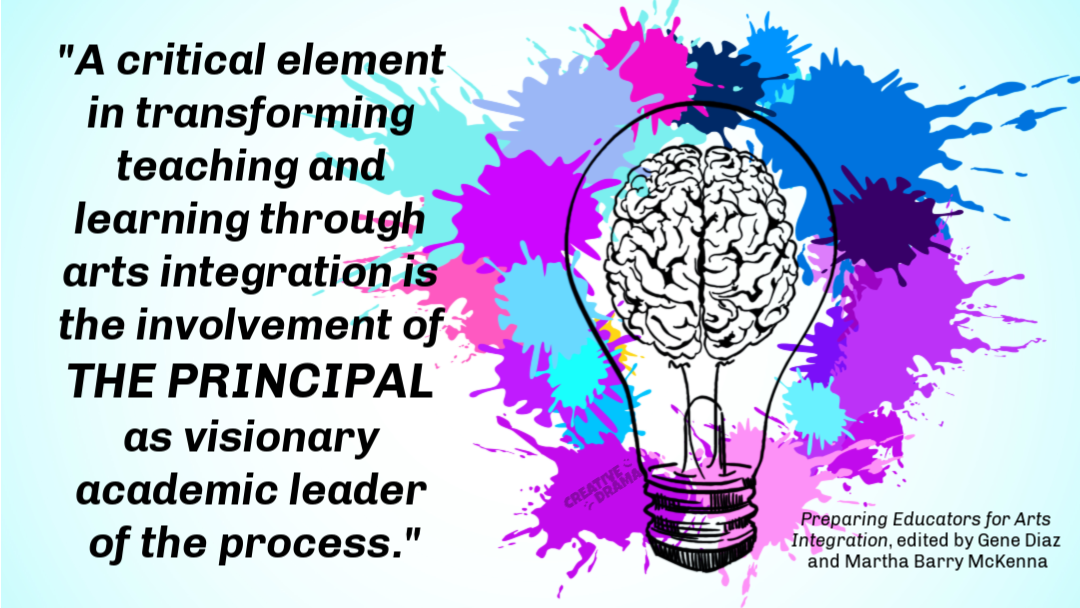
PART IV: ARTS SPECIALISTS IN ARTS INTEGRATION
“Championing the Way to Effective Arts Integration” by Joyce Huser and R. Scot Hockman
Huser and Hockman provide an overview of programs in three states that they see as exemplars in building a learning community for arts integration. The Colorado Department of Education has an “Arts Integration Compass Rose” that the authors summarize effectively (more so than the actual graphic does!) In South Carolina, The Arts in Basic Curriculum Project has a state Department of Education, an arts commission, and an arts college collaborating successfully. The ABC Project has developed “An Arts Infusion Continuum” as part of their work. Similarly, the Pennsylvania program – Art in Action – is a collaboration among an arts nonprofit, a university, and several elementary schools that provides free graduate coursework in arts integration to teachers.
The “Funding Sources” section Huser and Hockman include has a useful, if brief, overview of finding money for arts integration.
“Professional Learning in and Through the Arts” by Sibyl Barnum
Sibyl Barnum examined the influence of Arts Impact, a professional development program in Washington, on teacher ratings. This essay introduced me to the phrase “arts infused lesson” – which is “”one that teaches concepts that are authentically shared between two or more disciplines…for example, symmetry” (129). The Arts Impact website has many lesson plans and inspirations for arts integration.
Barnum also reminds teachers to grade performance-based assessments on understanding of criteria, not the aesthetic value of the performance: “Taking the qualitative judgement out of the assessment sets students up for success, and encourages students to refine and revise their work” (130).
PART V: ARTS INTEGRATION IN PRACTICE
Diaz and McKenna introduced me to another new term in the introduction to this section: transdisciplinary. They’re cognizant of the challenges for teachers, administrators, and artists working in this field; stating that it requires “the ability to work across disciplines integrating complex and abstract ideas” (137).
“SLANT: Professional Development and Science and Arts Integration” by Julia Marshall
Julie Marshall, as part of the Art Education Department at San Francisco State University, collaborated with the city’s Unified School District, the California Academy of Sciences, and the de Young Museum to create a professional development program called SLANT. Teachers worked mostly in visual arts media, integrating it with science curricula.
“Dance Literacy: A Pathway to Arts Integration” by Karen Bradley and Susan McGreevy-Nichols
Bradley and Nichols cover a lot of material in their article: The Conceptual Framework for the National Core Arts Standards,. how movement is primary in a child’s brain, and the effectiveness of using dance notation to teach literacy. All of these influenced the National Dance Education Organization’s Online Professional Development Institute; their professional development program has two courses in arts integration.
“The Resonant Heartbeat: Folk Dance, Physical Literacy, and Arts Integration” by Colleen Hearn Dean and Terry Sweeting
Dean and Sweeting demonstrate how folk dance can meet many needs for students and curricula. Folk dance is part of the Physical Education curriculum for elementary students in Pennsylvania; I agree with Dean and Sweeting that it’s an excellent candidate for arts integration. World Languages, Social Studies, and Literature all connect to folk dance. Dean and Sweeting mention in their articles that the University of California Northridge has an Integrated Teacher Education Program that features an Interdisciplinary Arts Concentration (scroll to the bottom of the page to see the courses required).
“Kansas: Pioneering Arts Integration” by Elaine Bernstorf
Bergstorf looks at Arts Integration programs in Kansas for individuals with special needs; giving an overview of their history. One of the examples she provides is a 1980s program by Very Special Arts (Now called VSA: The International Organization on Arts and Disability) that had students with disabilities performing for each other at the Wichita Art Museum. This is the first program I’ve read about where both the performers and the intended audience had disabilities.
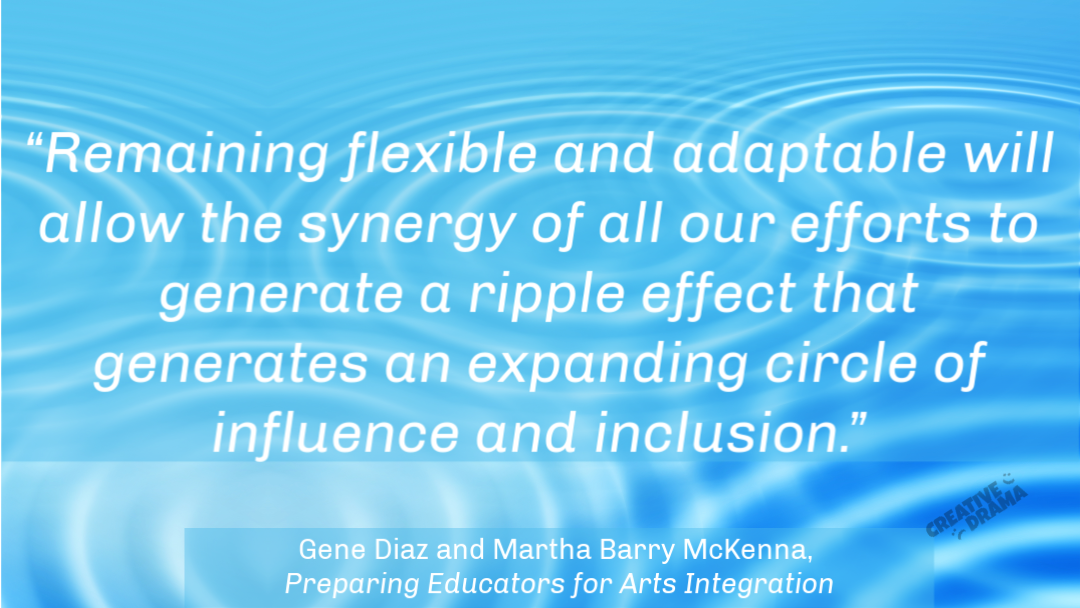
CONCLUSIONS and RECOMMENDATIONS
The final section of Preparing Educators for Arts Integration contains actionable recommendations from Diaz and McKenna. They’ve divided their conclusions into four parts; at the end of each there is a handy chart of the recommendation and a summary of the reasoning for the recommendation. All of the recommendations are sound ideas for arts integration; I’m highlighting just a few.
One of the options for providers of arts integration-based professional development for teachers is “include teachers and leaders together.” (184) This is an innovative idea I hope more programs will implement. I’ve rarely had a professional development experience, whether in a university course or a workshop, in which administrators were learning alongside teachers.
In the “Recommendations to Build Capacity in Schools,” Diaz and McKenna point out that arts integration has to “Ensure Support and Funding for Arts Specialists” (187). Arts specialists have seen jobs cut in lean budget years, leading to worries that their roles could be subsumed by classroom teachers who are integrating the arts. The arts specialists in a school should have an expanded role as a result of arts integration, not a lesser one. That is, arts integration work is in addition to a sequential arts curriculum, not “instead of.”
The “Policy Actions” section advocates requiring coursework in arts integration for English Language Learners (ELL) and Special Education credential candidates. Diaz and McKenna suggest that this will “enhance the capacity of teachers to reach all students” (191).
Diaz, Gene, Martha Barry McKenna, and Jane R. Best (eds.). Preparing Educators for Arts Integration: Placing Creativity at the Center of Learning. New York: Teachers College Press, 2017.
198 pages.
